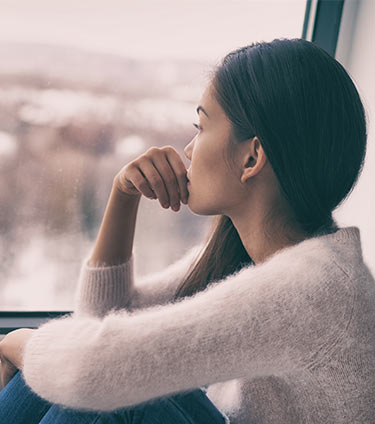

As winter approaches, it means shorter days and longer nights. However, the promise of long stretches of grey skies can bring about symptoms of seasonal affective disorder (SAD).
SAD is a form of depression triggered by weather changes and fewer daylight hours, typically occurring during the winter months. SAD symptoms may include changes in sleep patterns, such as oversleeping, appetite changes, such as carbohydrate cravings, weight gain, low energy, loss of interest in activities you previously enjoyed, and feeling hopeless or sad and down most days.
If you are one of the many people in the Pacific Northwest (PNW) that struggle with SAD, some of the tips below may help treat SAD and protect your mental health:
1. Get Fresh Air
Even if it's raining all day, take a few moments outside. It can seem ugly and gloomy up here in the PNW for days on end but try bundling up and taking a quick stroll down the road or even spending time under the eaves on your deck or patio with your coffee for a few minutes. Getting that fresh air, especially in the morning hours, can help wake you up and make you feel refreshed.
2. Regular Exercise
It can be hard to find motivation, but even a 15-minute walk can help boost your mood. However, when it is dark outside until 8am and dark again at 4pm, it can be challenging to get motivated to exercise. It also doesn’t provide much time to go for a walk, especially for those who have gone back to the office or other physical places of work outside of the home.
If you can, try to take a walk during your lunch break. Or, to help combat another side effect of SAD, like declining plans or feeling lonely, join a gym, dance class, or other activity. Not only will it keep you accountable, but it will also provide an opportunity to be social.
3. Stick to a Schedule
Changes in the amount of light outside can disrupt your circadian rhythm or internal clock. This can make it challenging to fall or stay asleep, contributing to sleep deprivation and increasing your risk of developing SAD.
Go to bed and wake up at the same time every day, even on weekends. Try not to over-sleep. Both under-sleeping and over-sleeping can affect your mood and overall health. If you’re an early riser or need to wake up early for work, find ways to help rouse you, even when it’s dark outside. Set your phone or alarm a distance away from you so you have to get up to turn it off physically. Try placing a cold washcloth on your face, especially your eyes.
For the evenings, practice good sleep hygiene, like avoiding caffeine in the late afternoon or evening, making sure your bedroom is quiet, dark, relaxing, and at a comfortable temperature, and turning off all electronics one hour before going to bed.
4. Take Vitamin D
Did you know exposure to natural sunlight helps the body make Vitamin D? Vitamin D helps absorb and retain calcium and phosphorus, which keeps bones healthy and strong, promotes cell growth, and supports immune function. In addition, some research has found that low levels of Vitamin D may be related to depression.
Sunlight is scarce in the winter months, and indoor lighting doesn’t provide the UV needed to stimulate Vitamin D production. This means many of us in the PNW have low levels of Vitamin D. A simple blood test can help determine your levels. Speak with your doctor before trying any new supplements.
5. Invest in a Light Therapy Box
In addition to taking a Vitamin D supplement, your doctor may recommend bright light therapy. Light therapy was pioneered in the 1980s by professor of psychiatry Norman E. Rosenthal. The therapy used a fluorescent light box with a diffuser screen to expose SAD patients to 10,000 LUX of light intensity for 30 minutes or 2,500 LUX for 1-2 hours.
The bright white fluorescent light helped patients achieve a statistically significant antidepressant effect measured by the Hamilton Depression Rating Scale (HDRS). Patients experienced the effects within the first 3–7 days following treatment. You can now buy SAD light therapy boxes to use at home to achieve the same results and alleviate symptoms of SAD.
Alternatives to traditional light therapy include dawn simulators, which use a bedside light that gradually increases the amount of illumination in the morning after waking, or evening treatments, which use brief exposure to bright light to stimulate melatonin production.
6. Maintain Your Social Life
Schedule activities with friends and family or have virtual game nights. Those affected by SAD tend to turn inward and have less motivation to attend gatherings and events. But staying active in your social life can really help when you’re feeling down. Make plans with loved ones and stick to them. Find fun winter activities like skiing and snowshoeing, or indoor activities like watching live music, going axe throwing, or a simple dinner with friends.
Always consult your healthcare provider before starting a new OTC Drug, supplement, diet, or exercise program or if you have or suspect you might have a health problem.
References:
https://www.everydayhealth.com/depression/treatment/ways-to-ease-seasonal-depression/
https://www.piedmont.org/living-better/5-ways-to-prevent-seasonal-depression
https://www.acpny.com/blog/mental-health/5-tips-to-avoid-seasonal-affective-disorder--s-a-d-
https://www.prevention.com/life/g20492338/prevent-winter-blues/
https://www.webmd.com/depression/features/beating-winters-woes
https://www.centura.org/story/vitamin-d-deficiency-and-seasonal-depression
https://www.healthline.com/nutrition/depression-and-vitamin-d



